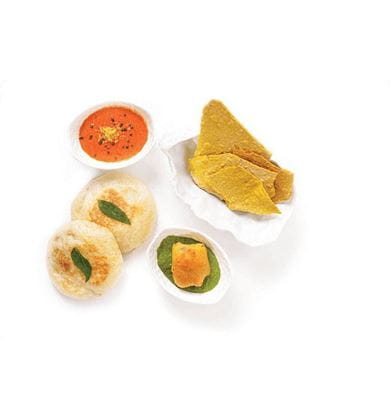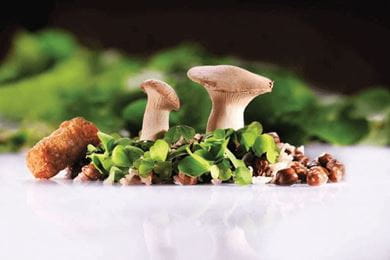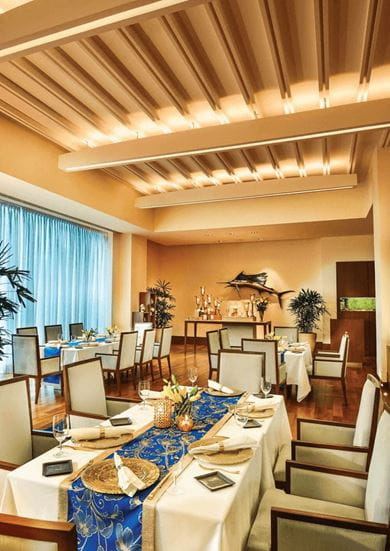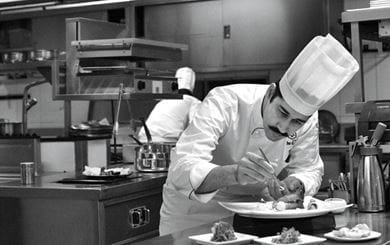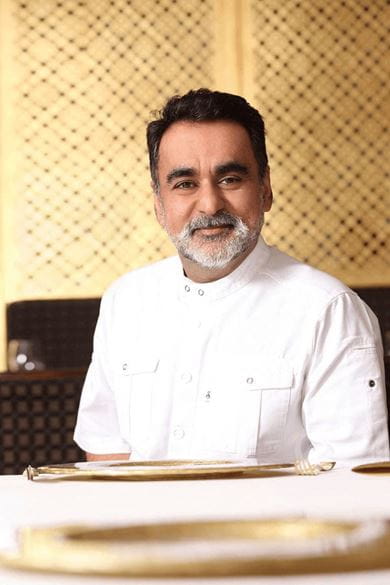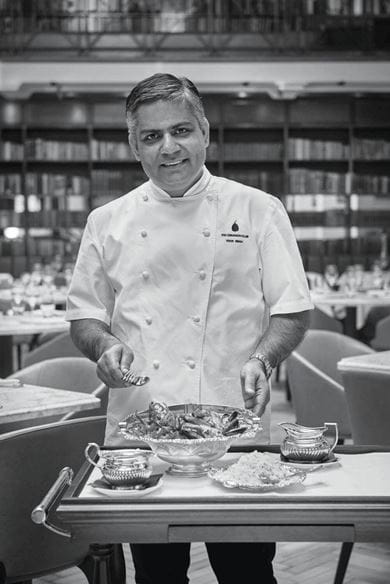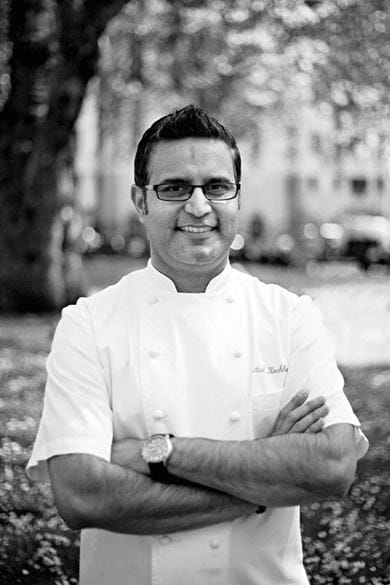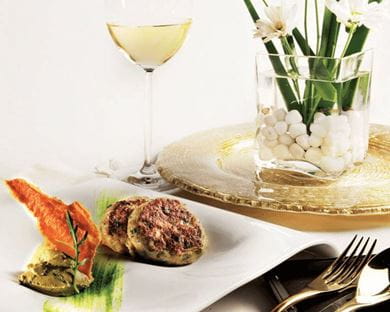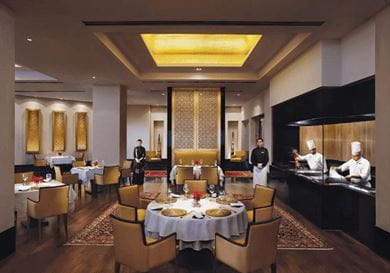






Modern Indian cuisine is coming into its own, with pioneering Indian chefs like Vineet Bhatia, Gaggan Anand, Tejas Sovani, Vivek Singh and Atul Kochhar leading the way
The first thing to remember, if you are trying to understand India, is that it is less a country, more a continent. Many of the world’s great religions (Islam and Christianity, for instance) came to India long before they reached Europe. Four great religions were created in the subcontinent (Hinduism, Buddhism, Jainism and Sikhism) and Jews, seeking refuge from persecution, found shelter in India centuries ago. There has never been any anti-Semiticism in India.
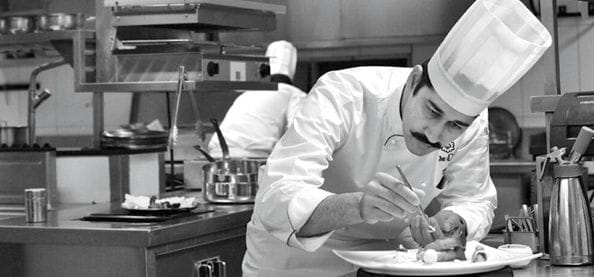
The geographical scope of the Indian sub-continent is vast, from the mighty Himalayas in the North to the deserts of Rajasthan in the West and the beaches of Kerala in the South. The ethnic diversity is unmatched: Kashmiris have fair skin and light eyes, the people of India’s Northeast have distinctly Oriental features and South Indians may be dark-haired and dark skinned. India has 23 official languages and the total number of mother tongues spoken in the country is a staggering 1,652. How, then, do you define the cuisine of a continent or at the very least, a subcontinent?
Consider the fact that till 1947, India included the countries that now comprise Pakistan and Bangladesh, and you have some idea of the complexity of the problem. Indians handle the cuisine issue by never talking about ‘Indian food’ just as Europeans rarely talk about ‘European food’ and Africans never use the term ‘African food’. Instead, we treat each cuisine as separate and distinct with perhaps one or two unifying features, such as the use of dry spices. We recognise that British and Bulgarian food have far more in common than, say, the cuisines of Kashmir and Nagaland.
So, what kind of food is served in “Indian” restaurants? Well, it rather depends on where you eat it. India has no great restaurant tradition and most restaurants date only from the second half of the 20th century. It was from 1950 onwards that (mostly) Punjabi restaurateurs set up restaurants all over India serving a cuisine that mixed North Indian Hindu and Muslim traditions and made extensive use of the tandoor for such dishes as chicken tikka and, of course, tandoori chicken. The vast majority of Indian restaurants in the UK, however, were owned not by Punjabis but by Bengalis from the Sylhet region (now part of Bangladesh) who set up curry houses. They did not serve their own Bengali cuisine but offered variations of the Punjabi restaurant menu. They also made up new dishes and gave them evocative names, though. A Madras curry may have been popular in Birmingham but it was unknown in Madras. A curry-house vindaloo had nothing in common with the Goan dish of that name.
This situation endured till the 1980s, when the cuisines of other parts of India began to be represented on restaurant menus – at least in India. At The Oberoi Group of Hotels and Resorts, for instance, the Mughal Room – the old flagship Indian restaurant – had its roots solidly in the Punjabi tradition. But Kandahar, which succeeded it, drew extensively from the food of the nawabs of Avadh in Utter Pradesh. But even as Indian restaurants began to discover their own cuisines, the pace of change hastened in London. Brits were tired of curry house vindaloos and longed for something that reflected India’s complex culinary heritage. A new generation of chefs, most of them Oberoi-trained, left India to open new restaurants in London. They adapted the European style of plated presentation (in India, all food is shared by the whole table) but recreated the flavours of the sub-continent, moving away from the Punjabi restaurant tradition.
The star was, of course Vineet Bhatia, who had been the chef at Kandahar at The Oberoi, Mumbai. Bhatia won great acclaim for his creative spin on Indian cooking, first at Zaika and then at Rasoi, both of which earned Michelin stars. Vineet opened Rasoi in Geneva and consulted for Indian restaurants around the world before coming back home to open Ziya at The Oberoi, Mumbai in the exact same space where he had once run the Kandahar kitchen. Other celebrated chefs included Atul Kochhar (also from The Oberoi, Mumbai) who won a Michelin star at Tamarind in London before opening his own Benaras in Berkeley Square. Vivek Singh, another ex-Oberoi chef, saw The Cinnamon Club become the favourite restaurant of British MPs and won rave reviews.
The London restaurants changed the way in which the world looked at Indian food. Till the Michelin stars began coming, Indian cuisine had been regarded by the West as being nothing more than cheap and cheerful. In the UK, restaurant-owners had little interest in explaining the rich traditions of real Indian food and Westerners had rarely tasted the real thing.
But even as the London chefs were winning stars and awards, another revolution was taking place in India. The chefs who had gone to London had found respect and had been given opportunities to experiment. Some of them transferred this new found freedom to Indian kitchens. Manish Mehrotra had worked at a Pan-Asian restaurant in London but had longed to come back to India and open a new kind of restaurant. While the London chefs competed with high-end European places, Manish knew that his challenge would be to take on the Indian restaurant sector in Delhi and make people think about food anew.
It helped that he was trained in Thai and Chinese cooking. So, he eschewed the Frenchified presentation of the London chefs and created his own kind of cuisine, using Indian references for his presentation and serving dishes that mingled food from all over India (Manish is from Bihar, grew up in Delhi and Mumbai, and married a South Indian). Indian Accent quickly became the most influential restaurant in India and chefs from Manish’s kitchen were lured away to start several highly successful restaurants in India and Dubai. In a sense, Indian Accent started a whole new wave of modern Indian food, one that owed little – except for its spirit – to the Michelin-starred London chefs.
Meanwhile, in another corner of Asia, a young Indian chef called Gaggan Anand was toiling away in a Bangkok hotel kitchen. Rajesh Kewalramani, a wealthy Indian who lived in Thailand, was one of Gaggan’s biggest fans. One day, he asked Gaggan if he wanted to start a restaurant of his own. “Yes,” said Gaggan. “But not the usual Indian food”. At that stage, molecular gastronomy was all the rage so Kewalramani urged Gaggan to go to Spain and work with El Bulli’s Ferran Adria. When Gaggan returned, they opened a restaurant which blended the new technology with Gaggan’s mastery of Indian flavours.
It took them less than a year to win global recognition and now, Gaggan is rated, for the third year in a row, as Asia’s Best Restaurant in a list of Asia’s Top 50 Restaurants. (Manish’s Indian Accent is the only other Indian restaurant on the list). He continues to grow as a chef and the molecular influences are now receding from his food. Between the great London chefs (chiefly Vineet Bhatia) and Manish and Gaggan, the nature of Indian restaurant food has changed. Yes, there are still very good traditional Indian restaurants but younger chefs are looking beyond Punjabi food for inspiration.
One example is the Masala Library/Farzi Café chain. At the more formal Masala Libraries (in Delhi and Mumbai), Chef Saurabh Udinia draws on the little known flavours of India’s Northeast (states like Nagaland and Mizoram) and merges them with South Indian and Goan spices to create a distinctive cuisine. At Farzi Café which, like Masala Library, is owned by Zorawar Kalra, the emphasis is on a younger demographic which now sees Indian food as hip and trendy.
And then, of course, there’s the award-winning Amaranta at The Oberoi, Gurgaon. When it opened, Amaranta recreated South Indian flavours, unfamiliar to Delhi diners, using fish that was freshly flown in from the coast every day. But over time, the chefs have become more ambitious. A stage at Noma in Copenhagen taught the current chef, Tejas Sovani, about the importance of ingredients (Indian cooking sometimes neglects ingredients while concentrating on spicing) and his current menu is unique: no Indian restaurant anywhere in the world interprets our cuisine in this manner.
What unites the cuisines of such chefs as Vineet Bhatia, Atul Kochar, Vivek Singh, Tejas Sovani, Sourabh Udinia, Gaggan Anand and Manish Mehrotra? It’s both difficult and easy to say.
It’s easy because they are all drawing inspiration from the same source: India’s rich culinary tradition. But it’s hard to say because in a complex and diverse country like India, there is no one tradition and no one cuisine. The genius of these chefs lies in the way that each has found something that is different but is still uniquely Indian.
When you are interpreting the cuisine of an entire subcontinent for the 21st century, you would expect nothing less.
Nita Mukesh Ambani Cultural Centre brings to the city a vibrant space for the world of music, dance, ...
I sometimes feel as though the legacy of Lord Kitchener has pursued me all of my life. I studied his ...
In 1992, Prince Charles, the Prince of Wales and heir to the British Throne visited India along with ...
Should one risk a vacation in the middle of pandemic? I thought long and hard about it before decidi ...
The Mona Lisa traces back herself to her artist Leonardo da Vinci’s life at Château du Clos Lucé in ...
The Oberoi Beach Resort, Lombok has undergone rejuvenation and evolved into a destination of unrival ...
A vivid tour through the hottest Bree Street’s central reaches that we call home to the ethical food ...
The Oberoi Beach Resort, Sahl Hasheesh, offers a royal experience amidst the colourful sea life at E ...
Located at the junction of Aravali and Vindhya ranges, Ranthambhore National Park was once a private ...
William Shakespeare lived through one of the most turbulent yet thrilling era’s of English history ...
While central Melbourne has its own allure, the city’s charm lies in its diverse suburbs, each of wh ...
Adrian Rohnfelder, a photographer with a keen interest in volcanoes and adventure, shares his extrao ...
Witness the journey of a wooden instrument that broke all the records to become the backbone of Arab ...
To leap beyond imposed restrictive limits of existence is precisely what Dimpy Menon’s artworks spea ...
More than just a circus, Phare performers use theater, music, dance and modern circus arts to tell u ...
Peru is one of the peak experiences in travel. Nowhere on earth is there such an incredibly wide ran ...
The Oberoi Sukhvilas Spa Resort, New Chandigarh helps you get in touch with yourself so that you liv ...
The establishment of the British Empire greatly influenced the architecture and culture of India an ...
Complete with red sandstone fort, torch lit ramparts and ‘Haveli’ mansions, The Oberoi Rajvilās, Jai ...
Come aboard The Oberoi Zahra, Luxury Nile Cruiser for a delightful mix of luxury and history ...
The incredible Turtle Sanctuary at The Oberoi Beach Resort, Bali, is a must-visit for nature lovers ...
As part of the Beatles, arguably the most iconic rock band of all time, John Lennon and Paul McCartn ...
Oberoi Hotels & Resorts have won the hearts of many with its exquisite charm and glorious stays ...
When I work with a subject, whether it is landscape or nudes, I’m in a relationship with whatever’s ...
Portugal’s capital city of blues from the ubiquitous blue tiling adorning buildings to fado, the sou ...
My conceptual concerts initiate dialogue using various art forms. I wanted to produce works that are ...
From sticky toffee pudding and gastro pubs, to farmers markets, heritage farm meat and stalls housin ...
German art historian Sebastian Schütze, a creative master and precise in technique, captures the hum ...
The Italian art witnessed drastic movements in the period between 1850 to 1950, giving a platform fo ...
All associated with Mughal emperors, maharajas and their courts, the Al Thani Collection is a marvel ...
In the age of art as speculative and subjective, beauty can seem very much beside the point. But sta ...
Complex narratives are the peak of excitement for me. Narratives like double portraits provide stimu ...
At the helm of his eponymous brand, Fendi and Chanel, the late Karl Lagerfeld became as iconic as th ...
Essentially an attempt to replicate a beautiful representation on the canvas, I hope to convey the c ...
The Oberoi, New Delhi’s makeover is an inspiration of the contemporary interpretation of Sir Edward ...
An institution rather than a hotel, the glorious Oberoi Grand, Kolkata is the place tradition calls ...
Ginarte is a journey into beauty, a harmonic synthesis, an expression of strength and delicacy, a hy ...
Oberoi Hotels & Resorts has been ranked the world’s Best Hotel Group at the Telegraph Travel Awards ...
With more than 400 displays, Toward a Concrete Utopia: Architecture in Yugoslavia, 1948–1980, is the ...
Life of the royals in medieval England, especially the queens, was full of intrigue and scandal but ...
The Asian art scene, though young, is booming and art fairs continue to play a significant role in t ...
From ebonised Georgian bracket to 19th-century French brass carriage and the 21st-century Jaeger Le- ...
The East India Company was one of the most powerful commercial endeavours the world has ever seen, d ...
With more than 400 displays, Toward a Concrete Utopia: Architecture in Yugoslavia, 1948–1980, is the ...
The Oberoi Rajvilas, Jaipur offers an exemplary experience of luxury that transports you to the gold ...
Winner of “Middle East’s Leading Luxury City Hotel” for five consecutive years by the coveted World ...
With elegantly designed villas that offer the best of interiors to its patrons, The Oberoi Beach Res ...
On the north-west coast of Africa lies Casablanca, an ancient exotic land embraced in the sweeping s ...
The new uniforms adorning the staff at The Oberoi, New Delhi are a reflection of The Oberoi Group’s ...
Swan Lake, the iconic ballet composed by Pyotr Ilyich Tchaikovsky in the late 19th century, continue ...
The Buddha, in his many iterations across South Asia, is most exquisitely represented in gilt-bronze ...
At luxury watch brand Carl F Bucherer, design is about bringing together form and function to create ...
Queen, temptress, politician, murderer: Cleopatra remains an object of fascination for writers, arti ...
Go pedal-to-metal with the best track-ready cars unveiled at the 2018 Geneva Motor Show ...
With an enchanting combination of natural splendour, medieval heritage and modern luxury, The Oberoi ...
The Oberoi Udaivilas, Udaipur, brings together the finest in nature, luxury and impeccable service t ...
The Oberoi Amarvilas, Agra, has been voted the Top India Resort Hotel at the Travel + Leisure, USA W ...
Swiss Photographer Christian Tagliavini captures 15th and 16th-century courtly culture in a series o ...
As innovations in air travel bring the UK and Australia closer, the Kangaroo Route – once stretched ...
The Oberoi, Gurgaon offers a traveller more than just the opulence of a five-star hotel: it is a san ...
In the year 1936, legendary artist Henri Matisse executed with the utmost elegance a charcoal portra ...
The elegant suites at The Oberoi, Mumbai, provide an unrivalled experience of The Oberoi Group’s sig ...
The art collection of David and Peggy Rockefeller has garnered the highest total for any private col ...
The Oberoi Philae, Luxury Nile Cruiser takes you through the highlights of the Egyptian river on a s ...
Complementing its signature old-world charm with the finest of contemporary facilities, this Oberoi ...
Truly great experiences in life, are integral to a design sensibility that seeks to create a visual ...
Sailing along the River Nile aboard The Oberoi Zahra, Nile Cruiser, explore Egypt’s mystical tombs a ...
Late entertainer David Bowie’s art collection, recently auctioned by Sotheby’s, is an eclectic mix o ...
Majestic lions, magnificent wild elephants and an untouched, untainted landscape weaving together na ...
From Jean Paul Gaultier and Christian Dior to Emilio Pucci and Christian Louboutin, international fa ...
world are among the most highly coveted collectible antiques today ...
Home to the perfect confluence of nature and concrete, Al Zorah gives to luxury travellers the getaw ...
An institution rather than a hotel, the glorious Oberoi Grand, Kolkata is the place tradition calls ...
Combine the exhilaration of a jungle adventure with the relaxation of a luxurious retreat at this sp ...
From exotic varieties to beautiful native species, trees can transform your estate into your own sli ...
The East and the West might speak distinct design languages, but bring them together and a spectacul ...
In the land of the midnight sun, a quintessential family vacation is punctuated by a breathtaking ex ...
The misty Wuyi mountains in Fujian, China are home to Da Hong Pao tea, which can sell for more than ...
Award-winning architect Francis Kéré talks about his design journey and giving back to his homeland ...
In Milan, designer Arthur Arbesser and his associates work and play together, perhaps setting a temp ...
Magnates of the luxury world have been taking charitable steps into the world of European applied ar ...
The culinary offerings at The Oberoi Beach Resort, Al Zorah, reflect its vibe of simple sophisticati ...
The works of 18th-century chaser-gilder Pierre Gouthiere stand testimony to the aesthetic opulence o ...
The inner health of an organisation is as important as the external forces that influence its ascent ...
The artistic traditions of mounted porcelain and enamelling lend a whimsical air to some of the most ...
The finest works of literature can sometimes make for the finest works of cinema, and the list of fi ...
The iconic Victorian writer and social critic, seen through the eyes of his great-great-great grandd ...
Be a part of the legacy of turtle conservation on the island of Bali at this luxurious beachside hav ...
With impeccable culinary offerings, Mauritian archaeological heritage and the best location on the i ...
As The Oberoi, New Delhi revels in its newly reopened avatar, take a trip down memory lane and follo ...
Passion, craftsmanship and innovation are the defining aspects of Automobili Lamborghini’s design ae ...
As the universe of food undergoes a rapid transformation across the world, The Oberoi, New Delhi’s a ...
Fashion photography is about more than garments and labels - it is about penetrating the physical fo ...
With an artistic masterpiece by Sir Winston Churchill, The Goldfish Pool at Chartwell, recently goin ...
Balancing modernity with its centuries-old heritage, Amsterdam is a study in splendour and historica ...
Dance does not exist in a box and no rules must necessarily govern it. It is a thing of beauty, myst ...
Nestled within an impregnable valley, the “lost city” of Petra is a spectacular expression of cultur ...
Oberoi Hotels & Resorts has been ranked the world’s Best Hotel Group at the Telegraph Travel Awards ...
Ayurveda, natural healing and mindfulness together create a space of rejuvenation like no other at ...
Beginning in the national capital, make your way through these travel hotspots across India that ref ...
Leonardo da Vinci’s Salvator Mundi claimed a place in auction history recently, setting a new record ...
As the beacon of Western classical music continues to shine bright, a younger generation of musician ...
One fine April morning, 16 actors and technicians set out to take Shakespeare’s Hamlet around the wo ...
From gold snuff boxes inset with diamonds, amethysts and sapphires to ornately enamelled perfume fla ...
The written word, in conjunction with innovations, lies at the very heart of history, shaping cultu ...
August 1947: It had been more than a week since freedom had arrived and the country partitioned. But ...
The Biennale des Antiquaires culminated this year in stunning glory, only to cast its spell afresh n ...
Over the years, I must have observed and recorded the behaviour of at least 125 tigers in Ranthambho ...
The ancient science of Ayurveda tells you how best to enhance your beauty and nourish not only your ...
The gleaming, fluorescent-green topsides of the superyacht Inouï may scream luxury at the Maxi Yacht ...
The world is changing and it is not changing to the benefit of the manufacturers and retailers of so ...
This season, drive in style with these uber-luxurious four-wheeled debutantes ...
The phrase, ‘home is where the heart is’ acquired a new meaning for the children at SOS Children’s V ...
India’s finest private collections of classical Indian art mindfully preserve its creative heritage ...
Make memories last forever by taking your most cherished photographs beyond the frame and photo albu ...
With breathtaking views, luxurious rooms, rejuvenating spa therapies and a state-of-the-art golf cou ...
Seamlessly weaving together traditional elements of Indian architecture, aesthetically landscaped ga ...
Exquisite collectibles going under the hammer are letting connoisseurs acquire a little bit of histo ...
Coming to India in 1865 as the principal of an art school, John Lockwood Kipling made an invaluable ...
When travelling along the path of kings and queens, The Oberoi Hotels & Resorts offer a palatial pla ...
For luxury travellers, the sky is the limit, quite literally, as a gourmet open-air meal at the base ...
From 18th-century ormolu clocks framed by candelabra to enamelled 19th-century timepieces, mantel cl ...
The Emirate of Ajman is home to The Oberoi Beach Resort, Al Zorah, a modern architectural masterpiec ...
The last queen of France was a great commissioner of beautiful things, and several of the shops she ...
From exclusive garments manufactured in Italy to style inspirations drawn from art, this is what the ...
A new facet of Pablo Picasso’s artistic repertoire is taking over the international art market his c ...
Every bottle of vintage wine has a story to tell. We give you the narratives behind five of the fine ...
In the universe of Modern art, rivalry is a complex dynamic that enables one artist to be influenced ...
A story is conditional – it is a matter of perception and might not always be, subliminally or even ...
From unique water and land activities to certified diving courses, desert tours and more, this all-s ...
Enrich your stay in Ranthambhore at this opulent jungle resort, in close proximity to nature, yet ne ...
With performative nuances and provocative appeal, Western classical music has evolved into a complex ...







Second child until maximum age of 12 years will be accommodated in the same room at additional supplement. The additional amount is not included in the room price mentioned and shall be payable at the hotel during check-out.
400 AED (including tax)
250 AED (including tax)

